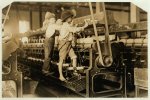The topic I have chosen for the final writing project is Lewis Hine. For those of you who do not know who Lewis Hine is, he was a photographer known for exposing child labor in factories in the United States. Hine worked for the National Child Labor Committee and went to factories to take photographs of the child laborers. His work was often very dangerous because the factories did not want Hine exposing their work, so Hine often had to wear disguises in order to sneak into the factories. According to this article, Russell Freedman, in his book, Kids at Work: Lewis Hine and the Crusade Against Child Labor, wrote, “At times, he was in real danger, risking physical attack when factory managers realized what he was up to…he put his life on the line in order to record a truthful picture of working children in early twentieth-century America.”

Hine began in his work with the NCLC in 1908, but it was not until 1938 that Congress passed the Fair Labor Standards Act, which prohibits child labor and is designed to protect their well being. It took 30 years for something to be done about the egregious instances of abuse of child labor that Hine brought to light. Hine died two years after the act was passed.


Lewis Hine is an excellent candidate for re-evaluation because what Hine did was an act of social justice. It was not considered as such at the time, but it was. Hine risked his life to bring attention to the child labor in the United States, even though it took so long for action to be taken to fix the problem. Hine was so much more than a photographer, he was an activist through social justice. He highlighted horrible stories through his photographs and without him, it would have taken much longer for the world to know just what exactly was going on in those factories.
One of the arguments against child labor in the early 20th century was that it took away many of the jobs that adults needed during the Great Depression. Do you think that this played a bigger role than the unfair working conditions, or that the argument was just another reason in the grand scheme of improving the lives of children?
LikeLike
These pictures are very effective! They show the brutal conditions these young kids had to work in. I never realized how young these children actually were when they were put to work. How effective do you think these pictures were at the time they were taken?
-Henry Linenger
LikeLike
Hey Lacey!
These are some great photos! Do you know if there were others like Lewis Hine who took photographs as a part of the National Child Labour Committee? Or was this a project/task that he started or created on his own? Also, how effective do you think using photographs are to expose the truth? Would its effectiveness be different in this era versus the past?
Michelle 🙂
LikeLike
Hi!
Wow, this is an incredible story. I remember learning about other like him in U.S. history that highlighted the negative aspects of urban life, etc., but I have never heard of Hine. What made you interested in him specifically or in the abolition of child labor?
LikeLike